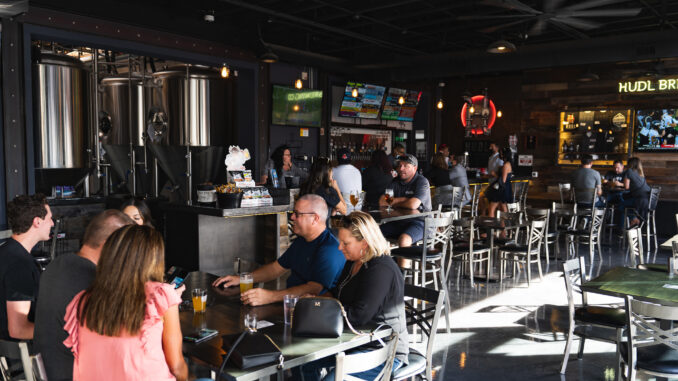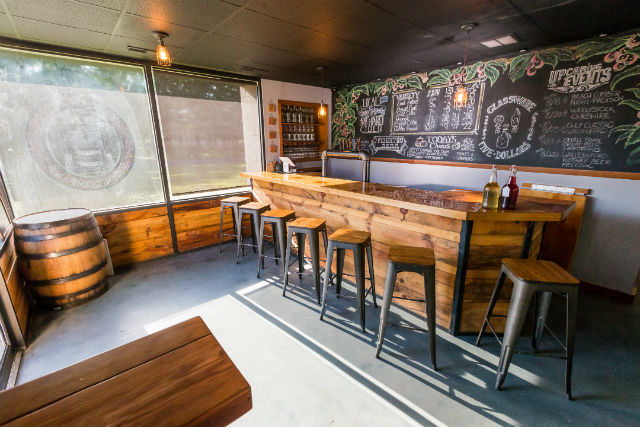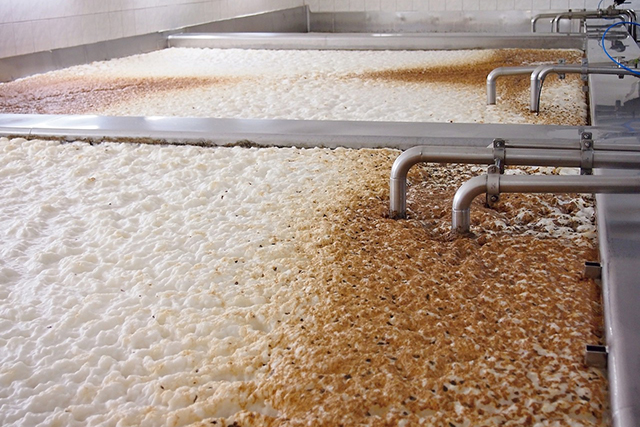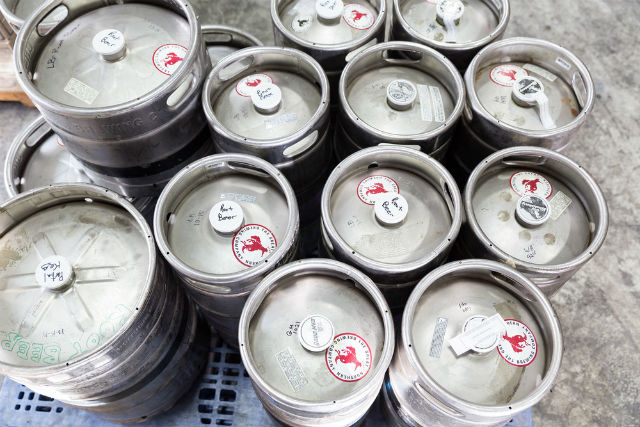
This is part of a continuing series of Q&As with members of the brewing community from across the US. Brewer Magazine will share business and personal insights from Brewmasters, Head Brewers, Brewing Managers, Sales Directors, QCQA Managers, and others each weekend to help you get to know each other better in the industry and learn more to develop your own brand.
With the annual Craft Brewers Conference starting Sunday, April 21, Brewer Magazine will chat with some of the local breweries in the Las Vegas area. Look for a CBC-Las Vegas preview in the latest print and digital edition as well.
Joe Cuozzo, Brewmaster, HUDL Brewing — Las Vegas
BREWER: You just hit your third anniversary in October of 2023. How has the business changed since starting during the pandemic?
CUOZZO: I think we’ve done a pretty good job lasting through all that. We did build up our distro out of here during that time. So I think your business model is always changing. No. 1, changing with the times and just changing on the adversity you had to go through. So, right now we’re really, really focused on building that monthly output, being able to stay up with rent increases, and being able to keep beer quality where it is. Our beers here definitely have a solid identity across the board. And I think keeping up with that quality, down the line — I’ve seen a lot of breweries that were making good beer that are cutting back and making poor decisions on that — being able to keep up our product quality is going to be huge for us. I think that’ll be the next task of next year, being able to keep your cost of goods and your price per pint as we do it here, now within a specific range. And I think as long as we can master that moving forward, I think we’re gonna be just fine.
BREWER: Do you feel it’s important to still have cans out in the market? Or do you think you can build yourself better as a taproom model with some to-go and kegs out there for handles?
CUOZZO: It’s kind of a necessary evil. You need someone that would normally never see your product in a Sprouts (Farmers Market) to take a look and see your handle. I think it’s important to go into a retail spot and represent a little bit. It might get somebody out to come inside the brewery. The realistic expectations are you aren’t going to make a ton of profit on it. It shouldn’t be the No. 1 goal. I think the No. 2 goal is just rotating the stock and making sure what is there is fresh. You’ve got to work hand-in-hand with your distributor. Making sure that when people actually do get a can of your beer, they’re not getting something from nine months ago, that’s a 5% beer that had nothing to help your shelf stability. We’re getting much better in trying to accomplish that. That’s an ongoing process, definitely not easy. But you need to have the presence out there.
BREWER: This is a local brewery, you want the locals, you have a ton of tourism coming through here. But how are you working on building the business in Brewery Row?
CUOZZO: I feel one of the biggest things for us is to get our local guild up and going a little bit better. We’re going to aim for three events. as President of the Southern Nevada Brewers Guild is getting that level of interest. We need to attract people that support local restaurants or support other local products. And we need to have a better relationship with those restaurants and with those other venues. Be more on the side of where the city needs help. Nothing is quick or easy. It’s taken a little bit more time than what we want. But slowly building and getting out that culture of who you are and where you’re going. Look back 15 years ago, there wasn’t one. Now taking a look at all these chefs who are moving out of the Strip. That restaurant culture has definitely changed even over the last seven, eight years since I’ve been back from Chicago. And that’s where we need to immerse ourselves and that’s where we need to get the support. The better they’re doing, the better we should be doing. We should be doing more pairings with their menus and be more interactive. So that’ll be one of our goals moving forward is to build that local support. Doing things for our breweries where we’re purchasing beers for events. I know when I’m going to Denver, I expect specific things. You’re going to Fort Collins, I’m expecting Funkwerks or O’Dells, I’m expecting this eclectic beer culture. We need to really build that culture up. And we’ve been pretty lucky over the last couple of years. Matt Marino over an Able Baker makes terrific beer and a ton of respect for him and what he’s doing in an extremely busy brewery. They had a World Beer Cup Gold. We’ve been able to win a GABF medal since we opened here. Anthony Gibson (Tenaya Creek) and Matt Marino are the two most tendered brewers right now in Las Vegas. That old school mentality paying homage to old school beer styles and still being eclectic. If we take our knowledge and what we’re trying to all bring to the game, it’s gonna happen, it’s just taking a little bit longer than what’s needed. But nothing’s easy.
BREWER: How do you create culture? Is it is it something a brewery does? Is it something that people start bringing it in? Is it the consumers?
CUOZZO: It’s attitude, and it’s getting it into the public hands, that would normally never happen. And that’s one of the hardest things in Vegas is getting it to those hands of people that would normally never get your product. If you live in New York or Chicago, you walk out and you don’t need to do anything outside of your area. Better public transportation, if you want to go to to a different brewery or different area of town, is needed. We don’t have that here. We’ve got to figure out a way to get people to get out into our area. We don’t have the L, we don’t have the subway. The booze districts in Henderson, they’ve done a really good job over the years. And they bring an eclectic experience. Deadwood Meadery is making excellent mead, you have the winery right there and three breweries all that same complex, before you even hit Water Street. Water Street has surrounded itself with a couple of great restaurants also. It takes everybody. No. 1, your beer has got to be good. And I think you have to be a little bit arrogant that your beer is really good to get people to spend their money. I think about every single weekend I go out, how am I gonna go spend my money? The kids need this, my wife needs this. I gotta spend my money, I need a good quality product. Then what are we going to do different? Whether it’s different trivia nights, whether it’s working with local food places to get a cool experience, how can you immerse yourself in where people put you in the rotation of what what they’re going to do at night. I think the areas of town that we have like this district here, we’ve done a good job at trying to make that more interactive experience. Now we just need to go out, publicize it and get people to know who we all are.
BREWER: You seem very interested in making the science an important part of your brewing process as well.
CUOZZO: To really be good at this job is you have to taste and smell what you’re making and then build the recipe off that and I don’t think enough brewers out there have had the correct training or worked under enough brewers. I think I’m the best in the world at what I do: straight out. I’m very arrogant, very cocky in what I do. Lots of GABF and World Beer Cup medals. At the end of the day I’ve learned things from other great brewers and brewing in San Diego was an experience I could never take back. Working at Pizza Port and Alesmith when it was in its infancy stages, seeing dairy tanks, working with different equipment thinking about tank dynamics … there’s all these components come in on top of your recipe. We use the term Brewmaster way too loosely today. There’s not enough people who are in control of the beer. When I brew the beer, I’m in control. If there’s an issue, I know how to fix the issue. And that’s where having that science, that background that experience really, really, really, really helps. Take a look at other breweries that have had growth or are at capacity. I wouldn’t want Matt’s job at Able Baker, it’s hard to keep those tanks full, keep your yeast regime going, coming up with new recipes, new hops, making the beer profitable and worried about sales. That’s hard. Tenaya Creek, I think our biggest brewery volume wise in town, it’s very, very hard to be brewing those styles as well as they do every single time. So it’s taking that experience and really putting it forward. You have to love the job because the job sucks. The whole day is cleaning, inspecting tanks, caustic burns, acid burns, parasitic — which is what we need to sanitize our tanks — and the ability to take a look at your process and ask for input because you get so stuck in a tunnel. We do this this way. You transfer this way, we purge our tanks this way. It’s thinking outside that box. If you’re not thinking outside that box, you’re not getting second, third opinions, talking to other brewers about what what they do. You’re going to be behind.
Editor’s Note: Questions and replies edited for brevity and clarity




Be the first to comment